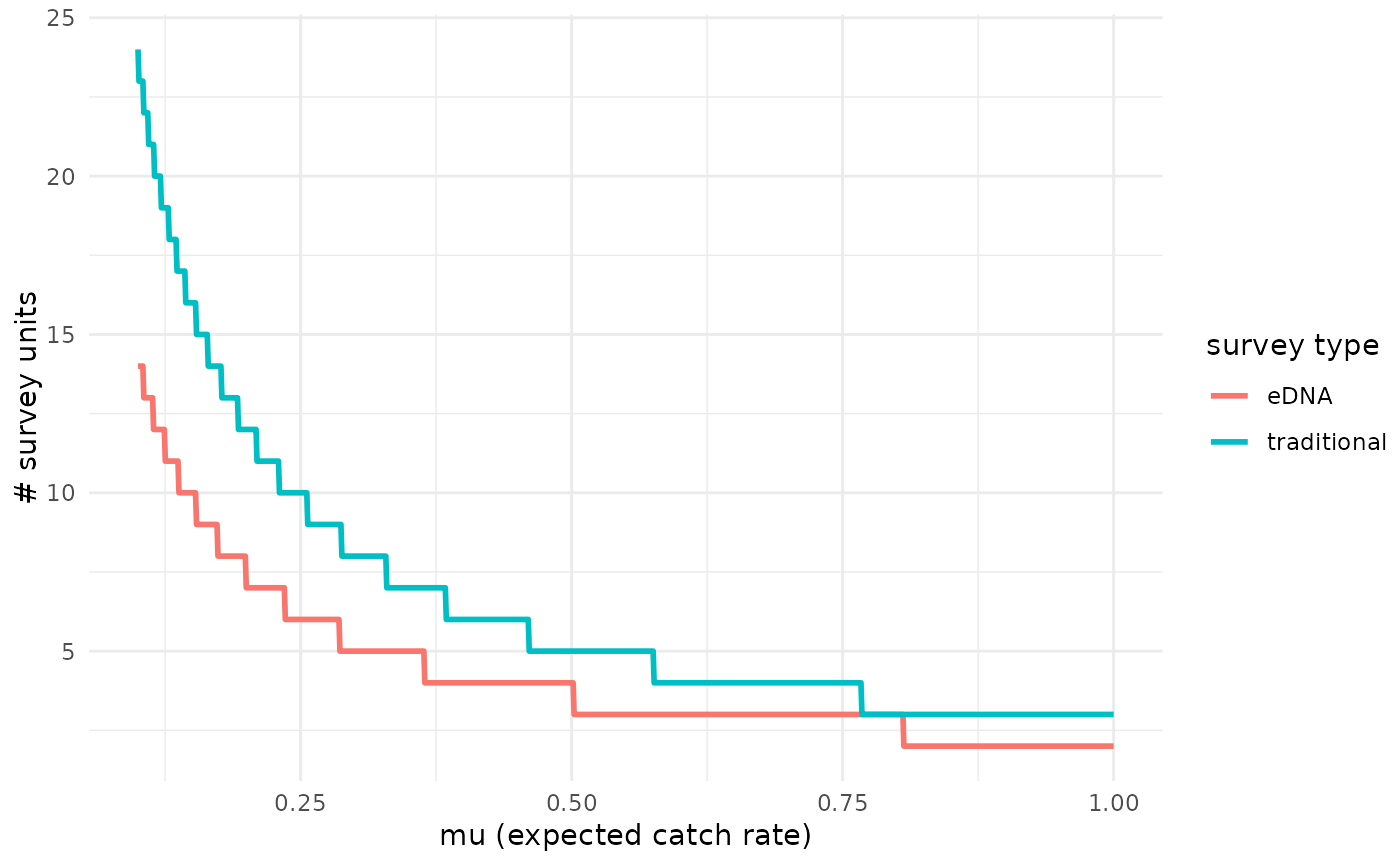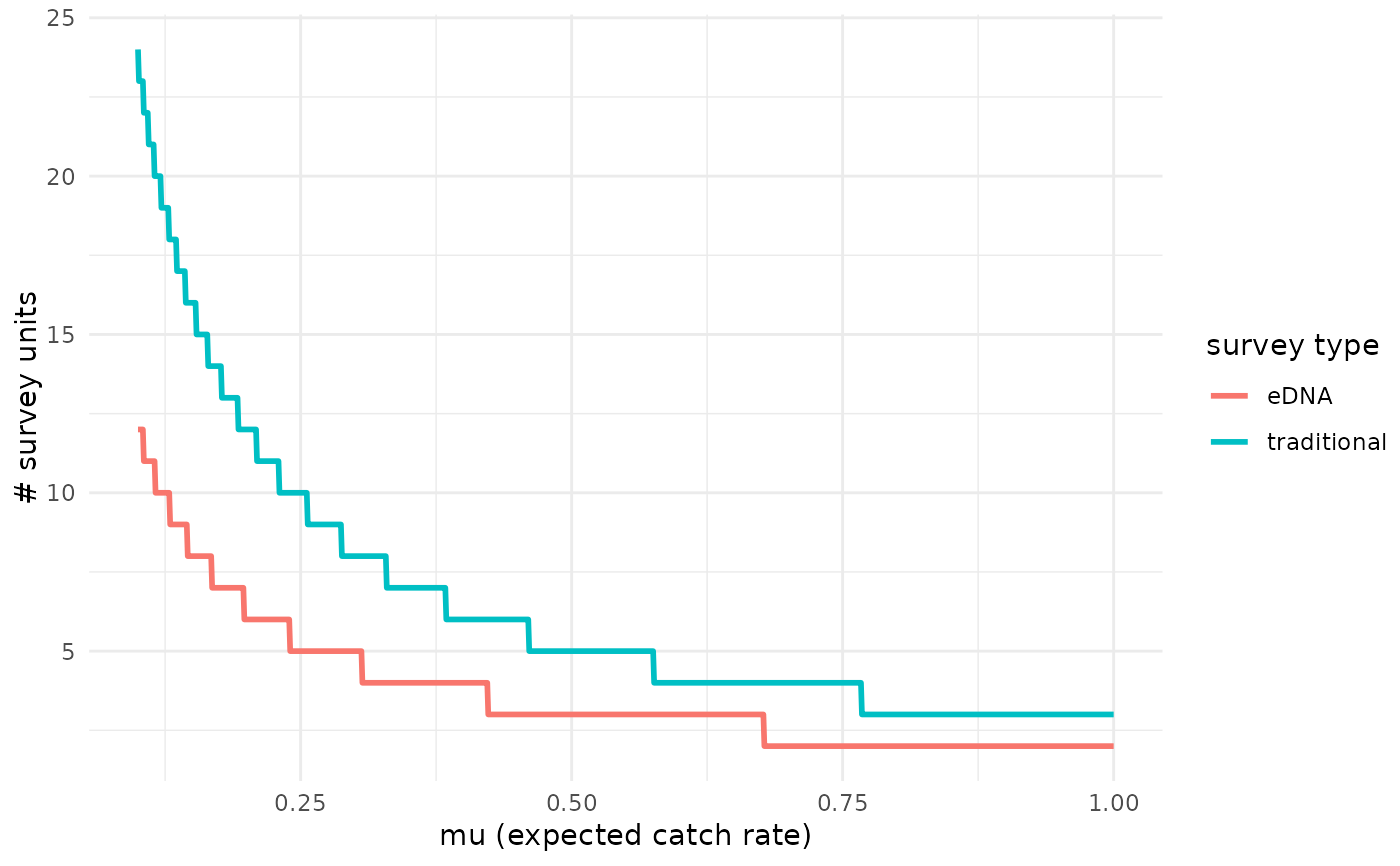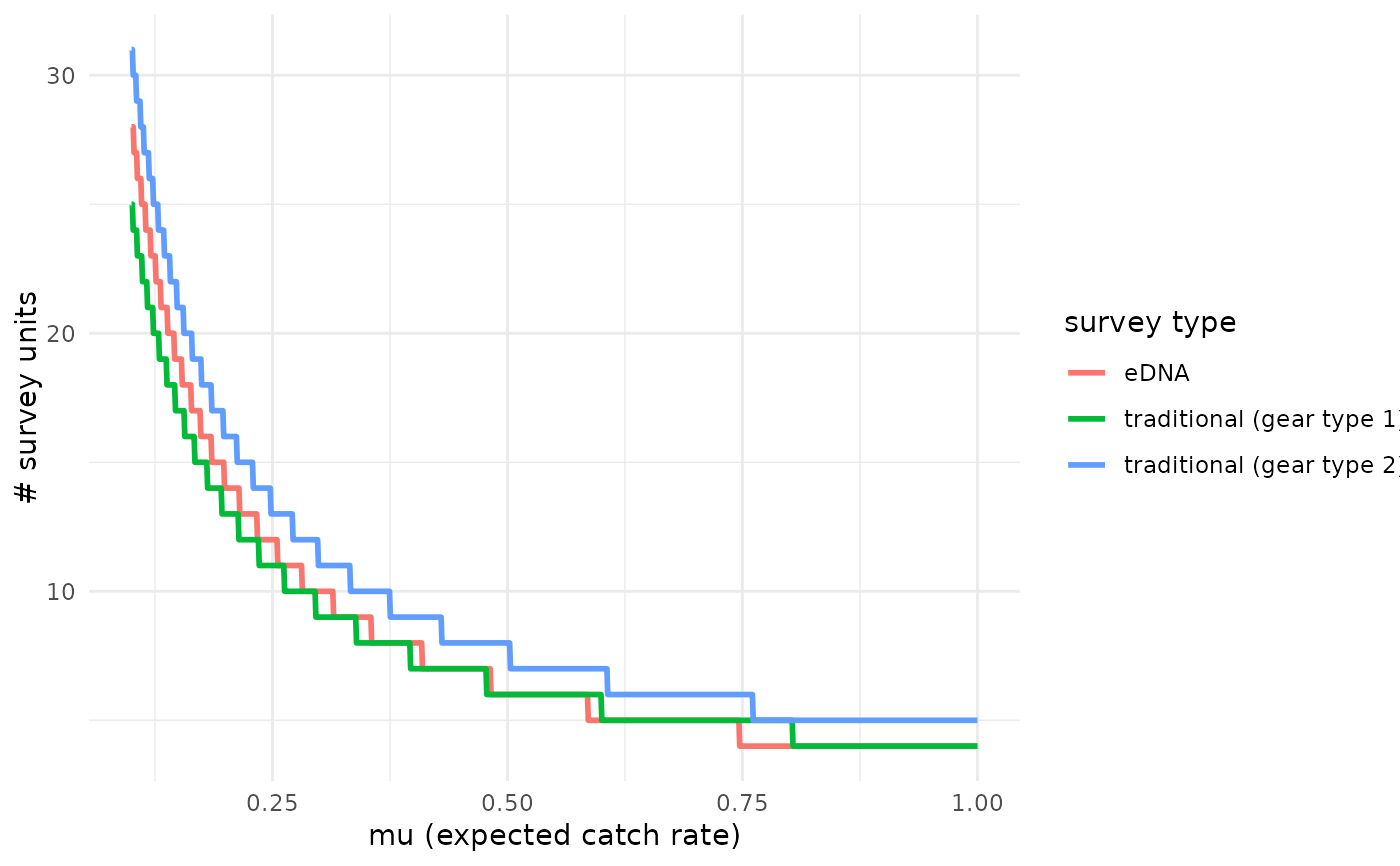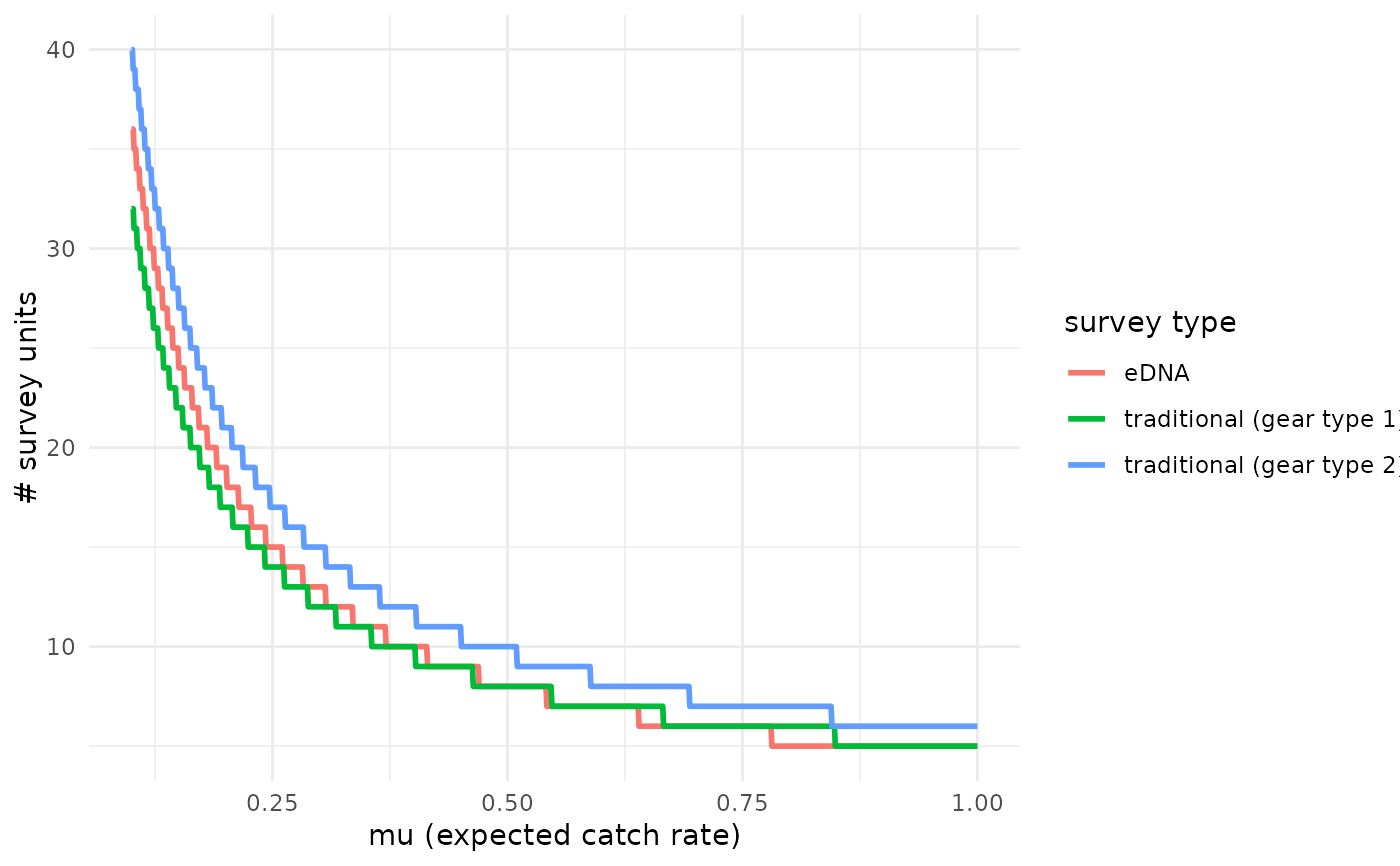
Plot the survey effort necessary to detect species presence, given the species expected catch rate.
Source:R/detection_plot.R
detection_plot.RdThis function plots the number of survey effort units to necessary detect species presence, calculated using median estimated parameter values from joint_model(). Detecting species presence is defined as producing at least one true positive eDNA detection or catching at least one individual. See more examples in the Package Vignette.
Arguments
- model_fit
An object of class
stanfit.- mu_min
A value indicating the minimum expected species catch rate for plotting. If multiple traditional gear types are represented in the model, mu is the catch rate of gear type 1.
- mu_max
A value indicating the maximum expected species catch rate for plotting. If multiple traditional gear types are represented in the model, mu is the catch rate of gear type 1.
- cov_val
A numeric vector indicating the values of site-level covariates to use for prediction. Default is NULL.
- probability
A numeric value indicating the probability of detecting presence. The default is 0.9.
- pcr_n
An integer indicating the number of PCR replicates per eDNA sample. The default is 3.
Value
A plot displaying survey efforts necessary to detect species presence, given mu, for each survey type.
Note
Before fitting the model, this function checks to ensure that the function is possible given the inputs. These checks include:
Input model fit is an object of class 'stanfit'.
Input mu_min is a numeric value greater than 0.
Input mu_max is a numeric value.
If model fit contains alpha, cov_val must be provided.
Input cov_val is numeric.
Input cov_val is the same length as the number of estimated covariates.
Input probability is a univariate numeric value.
Input model fit has converged (i.e. no divergent transitions after warm-up).
If any of these checks fail, the function returns an error message.
Examples
# \donttest{
# Ex. 1: Calculating necessary effort for detection with site-level
# covariates
# Load data
data(goby_data)
# Fit a model including 'Filter_time' and 'Salinity' site-level covariates
fit_cov <- joint_model(data = goby_data, cov = c('Filter_time','Salinity'),
family = "poisson", p10_priors = c(1,20), q = FALSE,
multicore = FALSE)
#>
#> SAMPLING FOR MODEL 'joint_count' NOW (CHAIN 1).
#> Chain 1:
#> Chain 1: Gradient evaluation took 3.4e-05 seconds
#> Chain 1: 1000 transitions using 10 leapfrog steps per transition would take 0.34 seconds.
#> Chain 1: Adjust your expectations accordingly!
#> Chain 1:
#> Chain 1:
#> Chain 1: Iteration: 1 / 3000 [ 0%] (Warmup)
#> Chain 1: Iteration: 500 / 3000 [ 16%] (Warmup)
#> Chain 1: Iteration: 501 / 3000 [ 16%] (Sampling)
#> Chain 1: Iteration: 1000 / 3000 [ 33%] (Sampling)
#> Chain 1: Iteration: 1500 / 3000 [ 50%] (Sampling)
#> Chain 1: Iteration: 2000 / 3000 [ 66%] (Sampling)
#> Chain 1: Iteration: 2500 / 3000 [ 83%] (Sampling)
#> Chain 1: Iteration: 3000 / 3000 [100%] (Sampling)
#> Chain 1:
#> Chain 1: Elapsed Time: 1.536 seconds (Warm-up)
#> Chain 1: 2.17 seconds (Sampling)
#> Chain 1: 3.706 seconds (Total)
#> Chain 1:
#>
#> SAMPLING FOR MODEL 'joint_count' NOW (CHAIN 2).
#> Chain 2:
#> Chain 2: Gradient evaluation took 3.1e-05 seconds
#> Chain 2: 1000 transitions using 10 leapfrog steps per transition would take 0.31 seconds.
#> Chain 2: Adjust your expectations accordingly!
#> Chain 2:
#> Chain 2:
#> Chain 2: Iteration: 1 / 3000 [ 0%] (Warmup)
#> Chain 2: Iteration: 500 / 3000 [ 16%] (Warmup)
#> Chain 2: Iteration: 501 / 3000 [ 16%] (Sampling)
#> Chain 2: Iteration: 1000 / 3000 [ 33%] (Sampling)
#> Chain 2: Iteration: 1500 / 3000 [ 50%] (Sampling)
#> Chain 2: Iteration: 2000 / 3000 [ 66%] (Sampling)
#> Chain 2: Iteration: 2500 / 3000 [ 83%] (Sampling)
#> Chain 2: Iteration: 3000 / 3000 [100%] (Sampling)
#> Chain 2:
#> Chain 2: Elapsed Time: 0.431 seconds (Warm-up)
#> Chain 2: 0.91 seconds (Sampling)
#> Chain 2: 1.341 seconds (Total)
#> Chain 2:
#>
#> SAMPLING FOR MODEL 'joint_count' NOW (CHAIN 3).
#> Chain 3:
#> Chain 3: Gradient evaluation took 2.8e-05 seconds
#> Chain 3: 1000 transitions using 10 leapfrog steps per transition would take 0.28 seconds.
#> Chain 3: Adjust your expectations accordingly!
#> Chain 3:
#> Chain 3:
#> Chain 3: Iteration: 1 / 3000 [ 0%] (Warmup)
#> Chain 3: Iteration: 500 / 3000 [ 16%] (Warmup)
#> Chain 3: Iteration: 501 / 3000 [ 16%] (Sampling)
#> Chain 3: Iteration: 1000 / 3000 [ 33%] (Sampling)
#> Chain 3: Iteration: 1500 / 3000 [ 50%] (Sampling)
#> Chain 3: Iteration: 2000 / 3000 [ 66%] (Sampling)
#> Chain 3: Iteration: 2500 / 3000 [ 83%] (Sampling)
#> Chain 3: Iteration: 3000 / 3000 [100%] (Sampling)
#> Chain 3:
#> Chain 3: Elapsed Time: 0.691 seconds (Warm-up)
#> Chain 3: 0.902 seconds (Sampling)
#> Chain 3: 1.593 seconds (Total)
#> Chain 3:
#>
#> SAMPLING FOR MODEL 'joint_count' NOW (CHAIN 4).
#> Chain 4:
#> Chain 4: Gradient evaluation took 2.8e-05 seconds
#> Chain 4: 1000 transitions using 10 leapfrog steps per transition would take 0.28 seconds.
#> Chain 4: Adjust your expectations accordingly!
#> Chain 4:
#> Chain 4:
#> Chain 4: Iteration: 1 / 3000 [ 0%] (Warmup)
#> Chain 4: Iteration: 500 / 3000 [ 16%] (Warmup)
#> Chain 4: Iteration: 501 / 3000 [ 16%] (Sampling)
#> Chain 4: Iteration: 1000 / 3000 [ 33%] (Sampling)
#> Chain 4: Iteration: 1500 / 3000 [ 50%] (Sampling)
#> Chain 4: Iteration: 2000 / 3000 [ 66%] (Sampling)
#> Chain 4: Iteration: 2500 / 3000 [ 83%] (Sampling)
#> Chain 4: Iteration: 3000 / 3000 [100%] (Sampling)
#> Chain 4:
#> Chain 4: Elapsed Time: 0.404 seconds (Warm-up)
#> Chain 4: 0.896 seconds (Sampling)
#> Chain 4: 1.3 seconds (Total)
#> Chain 4:
#> Refer to the eDNAjoint guide for visualization tips: https://ednajoint.netlify.app/tips#visualization-tips
# Plot at the mean covariate values (covariates are standardized, so mean=0)
detection_plot(fit_cov$model, mu_min = 0.1, mu_max = 1,
cov_val = c(0,0), pcr_n = 3)
 # Calculate mu_critical at salinity 0.5 z-scores greater than the mean
detection_plot(fit_cov$model, mu_min = 0.1, mu_max = 1, cov_val = c(0,0.5),
pcr_n = 3)
# Calculate mu_critical at salinity 0.5 z-scores greater than the mean
detection_plot(fit_cov$model, mu_min = 0.1, mu_max = 1, cov_val = c(0,0.5),
pcr_n = 3)
 # Ex. 2: Calculating necessary effort for detection with multiple
# traditional gear types
# Load data
data(green_crab_data)
# Fit a model with no site-level covariates
fit_q <- joint_model(data = green_crab_data, cov = NULL, family = "negbin",
p10_priors = c(1,20), q = TRUE,
multicore = FALSE)
#>
#> SAMPLING FOR MODEL 'joint_count' NOW (CHAIN 1).
#> Chain 1:
#> Chain 1: Gradient evaluation took 0.000432 seconds
#> Chain 1: 1000 transitions using 10 leapfrog steps per transition would take 4.32 seconds.
#> Chain 1: Adjust your expectations accordingly!
#> Chain 1:
#> Chain 1:
#> Chain 1: Iteration: 1 / 3000 [ 0%] (Warmup)
#> Chain 1: Iteration: 500 / 3000 [ 16%] (Warmup)
#> Chain 1: Iteration: 501 / 3000 [ 16%] (Sampling)
#> Chain 1: Iteration: 1000 / 3000 [ 33%] (Sampling)
#> Chain 1: Iteration: 1500 / 3000 [ 50%] (Sampling)
#> Chain 1: Iteration: 2000 / 3000 [ 66%] (Sampling)
#> Chain 1: Iteration: 2500 / 3000 [ 83%] (Sampling)
#> Chain 1: Iteration: 3000 / 3000 [100%] (Sampling)
#> Chain 1:
#> Chain 1: Elapsed Time: 4.921 seconds (Warm-up)
#> Chain 1: 16.01 seconds (Sampling)
#> Chain 1: 20.931 seconds (Total)
#> Chain 1:
#>
#> SAMPLING FOR MODEL 'joint_count' NOW (CHAIN 2).
#> Chain 2:
#> Chain 2: Gradient evaluation took 0.000405 seconds
#> Chain 2: 1000 transitions using 10 leapfrog steps per transition would take 4.05 seconds.
#> Chain 2: Adjust your expectations accordingly!
#> Chain 2:
#> Chain 2:
#> Chain 2: Iteration: 1 / 3000 [ 0%] (Warmup)
#> Chain 2: Iteration: 500 / 3000 [ 16%] (Warmup)
#> Chain 2: Iteration: 501 / 3000 [ 16%] (Sampling)
#> Chain 2: Iteration: 1000 / 3000 [ 33%] (Sampling)
#> Chain 2: Iteration: 1500 / 3000 [ 50%] (Sampling)
#> Chain 2: Iteration: 2000 / 3000 [ 66%] (Sampling)
#> Chain 2: Iteration: 2500 / 3000 [ 83%] (Sampling)
#> Chain 2: Iteration: 3000 / 3000 [100%] (Sampling)
#> Chain 2:
#> Chain 2: Elapsed Time: 4.744 seconds (Warm-up)
#> Chain 2: 14.183 seconds (Sampling)
#> Chain 2: 18.927 seconds (Total)
#> Chain 2:
#>
#> SAMPLING FOR MODEL 'joint_count' NOW (CHAIN 3).
#> Chain 3:
#> Chain 3: Gradient evaluation took 0.000447 seconds
#> Chain 3: 1000 transitions using 10 leapfrog steps per transition would take 4.47 seconds.
#> Chain 3: Adjust your expectations accordingly!
#> Chain 3:
#> Chain 3:
#> Chain 3: Iteration: 1 / 3000 [ 0%] (Warmup)
#> Chain 3: Iteration: 500 / 3000 [ 16%] (Warmup)
#> Chain 3: Iteration: 501 / 3000 [ 16%] (Sampling)
#> Chain 3: Iteration: 1000 / 3000 [ 33%] (Sampling)
#> Chain 3: Iteration: 1500 / 3000 [ 50%] (Sampling)
#> Chain 3: Iteration: 2000 / 3000 [ 66%] (Sampling)
#> Chain 3: Iteration: 2500 / 3000 [ 83%] (Sampling)
#> Chain 3: Iteration: 3000 / 3000 [100%] (Sampling)
#> Chain 3:
#> Chain 3: Elapsed Time: 4.778 seconds (Warm-up)
#> Chain 3: 10.85 seconds (Sampling)
#> Chain 3: 15.628 seconds (Total)
#> Chain 3:
#>
#> SAMPLING FOR MODEL 'joint_count' NOW (CHAIN 4).
#> Chain 4:
#> Chain 4: Gradient evaluation took 0.00041 seconds
#> Chain 4: 1000 transitions using 10 leapfrog steps per transition would take 4.1 seconds.
#> Chain 4: Adjust your expectations accordingly!
#> Chain 4:
#> Chain 4:
#> Chain 4: Iteration: 1 / 3000 [ 0%] (Warmup)
#> Chain 4: Iteration: 500 / 3000 [ 16%] (Warmup)
#> Chain 4: Iteration: 501 / 3000 [ 16%] (Sampling)
#> Chain 4: Iteration: 1000 / 3000 [ 33%] (Sampling)
#> Chain 4: Iteration: 1500 / 3000 [ 50%] (Sampling)
#> Chain 4: Iteration: 2000 / 3000 [ 66%] (Sampling)
#> Chain 4: Iteration: 2500 / 3000 [ 83%] (Sampling)
#> Chain 4: Iteration: 3000 / 3000 [100%] (Sampling)
#> Chain 4:
#> Chain 4: Elapsed Time: 4.673 seconds (Warm-up)
#> Chain 4: 11.423 seconds (Sampling)
#> Chain 4: 16.096 seconds (Total)
#> Chain 4:
#> Refer to the eDNAjoint guide for visualization tips: https://ednajoint.netlify.app/tips#visualization-tips
# Calculate
detection_plot(fit_q$model, mu_min = 0.1, mu_max = 1,
cov_val = NULL, pcr_n = 3)
# Ex. 2: Calculating necessary effort for detection with multiple
# traditional gear types
# Load data
data(green_crab_data)
# Fit a model with no site-level covariates
fit_q <- joint_model(data = green_crab_data, cov = NULL, family = "negbin",
p10_priors = c(1,20), q = TRUE,
multicore = FALSE)
#>
#> SAMPLING FOR MODEL 'joint_count' NOW (CHAIN 1).
#> Chain 1:
#> Chain 1: Gradient evaluation took 0.000432 seconds
#> Chain 1: 1000 transitions using 10 leapfrog steps per transition would take 4.32 seconds.
#> Chain 1: Adjust your expectations accordingly!
#> Chain 1:
#> Chain 1:
#> Chain 1: Iteration: 1 / 3000 [ 0%] (Warmup)
#> Chain 1: Iteration: 500 / 3000 [ 16%] (Warmup)
#> Chain 1: Iteration: 501 / 3000 [ 16%] (Sampling)
#> Chain 1: Iteration: 1000 / 3000 [ 33%] (Sampling)
#> Chain 1: Iteration: 1500 / 3000 [ 50%] (Sampling)
#> Chain 1: Iteration: 2000 / 3000 [ 66%] (Sampling)
#> Chain 1: Iteration: 2500 / 3000 [ 83%] (Sampling)
#> Chain 1: Iteration: 3000 / 3000 [100%] (Sampling)
#> Chain 1:
#> Chain 1: Elapsed Time: 4.921 seconds (Warm-up)
#> Chain 1: 16.01 seconds (Sampling)
#> Chain 1: 20.931 seconds (Total)
#> Chain 1:
#>
#> SAMPLING FOR MODEL 'joint_count' NOW (CHAIN 2).
#> Chain 2:
#> Chain 2: Gradient evaluation took 0.000405 seconds
#> Chain 2: 1000 transitions using 10 leapfrog steps per transition would take 4.05 seconds.
#> Chain 2: Adjust your expectations accordingly!
#> Chain 2:
#> Chain 2:
#> Chain 2: Iteration: 1 / 3000 [ 0%] (Warmup)
#> Chain 2: Iteration: 500 / 3000 [ 16%] (Warmup)
#> Chain 2: Iteration: 501 / 3000 [ 16%] (Sampling)
#> Chain 2: Iteration: 1000 / 3000 [ 33%] (Sampling)
#> Chain 2: Iteration: 1500 / 3000 [ 50%] (Sampling)
#> Chain 2: Iteration: 2000 / 3000 [ 66%] (Sampling)
#> Chain 2: Iteration: 2500 / 3000 [ 83%] (Sampling)
#> Chain 2: Iteration: 3000 / 3000 [100%] (Sampling)
#> Chain 2:
#> Chain 2: Elapsed Time: 4.744 seconds (Warm-up)
#> Chain 2: 14.183 seconds (Sampling)
#> Chain 2: 18.927 seconds (Total)
#> Chain 2:
#>
#> SAMPLING FOR MODEL 'joint_count' NOW (CHAIN 3).
#> Chain 3:
#> Chain 3: Gradient evaluation took 0.000447 seconds
#> Chain 3: 1000 transitions using 10 leapfrog steps per transition would take 4.47 seconds.
#> Chain 3: Adjust your expectations accordingly!
#> Chain 3:
#> Chain 3:
#> Chain 3: Iteration: 1 / 3000 [ 0%] (Warmup)
#> Chain 3: Iteration: 500 / 3000 [ 16%] (Warmup)
#> Chain 3: Iteration: 501 / 3000 [ 16%] (Sampling)
#> Chain 3: Iteration: 1000 / 3000 [ 33%] (Sampling)
#> Chain 3: Iteration: 1500 / 3000 [ 50%] (Sampling)
#> Chain 3: Iteration: 2000 / 3000 [ 66%] (Sampling)
#> Chain 3: Iteration: 2500 / 3000 [ 83%] (Sampling)
#> Chain 3: Iteration: 3000 / 3000 [100%] (Sampling)
#> Chain 3:
#> Chain 3: Elapsed Time: 4.778 seconds (Warm-up)
#> Chain 3: 10.85 seconds (Sampling)
#> Chain 3: 15.628 seconds (Total)
#> Chain 3:
#>
#> SAMPLING FOR MODEL 'joint_count' NOW (CHAIN 4).
#> Chain 4:
#> Chain 4: Gradient evaluation took 0.00041 seconds
#> Chain 4: 1000 transitions using 10 leapfrog steps per transition would take 4.1 seconds.
#> Chain 4: Adjust your expectations accordingly!
#> Chain 4:
#> Chain 4:
#> Chain 4: Iteration: 1 / 3000 [ 0%] (Warmup)
#> Chain 4: Iteration: 500 / 3000 [ 16%] (Warmup)
#> Chain 4: Iteration: 501 / 3000 [ 16%] (Sampling)
#> Chain 4: Iteration: 1000 / 3000 [ 33%] (Sampling)
#> Chain 4: Iteration: 1500 / 3000 [ 50%] (Sampling)
#> Chain 4: Iteration: 2000 / 3000 [ 66%] (Sampling)
#> Chain 4: Iteration: 2500 / 3000 [ 83%] (Sampling)
#> Chain 4: Iteration: 3000 / 3000 [100%] (Sampling)
#> Chain 4:
#> Chain 4: Elapsed Time: 4.673 seconds (Warm-up)
#> Chain 4: 11.423 seconds (Sampling)
#> Chain 4: 16.096 seconds (Total)
#> Chain 4:
#> Refer to the eDNAjoint guide for visualization tips: https://ednajoint.netlify.app/tips#visualization-tips
# Calculate
detection_plot(fit_q$model, mu_min = 0.1, mu_max = 1,
cov_val = NULL, pcr_n = 3)
 # Change probability of detecting presence to 0.95
detection_plot(fit_q$model, mu_min = 0.1, mu_max = 1, cov_val = NULL,
probability = 0.95, pcr_n = 3)
# Change probability of detecting presence to 0.95
detection_plot(fit_q$model, mu_min = 0.1, mu_max = 1, cov_val = NULL,
probability = 0.95, pcr_n = 3)
 # }
# }